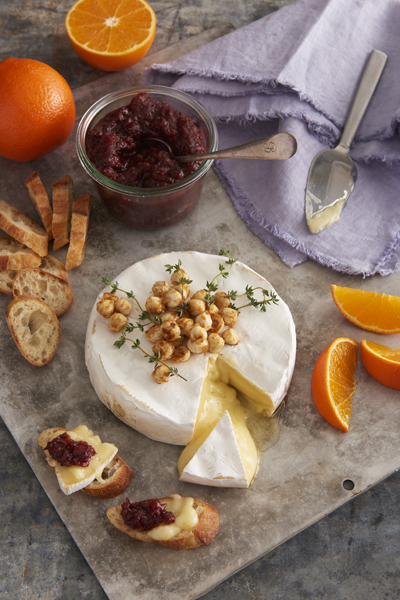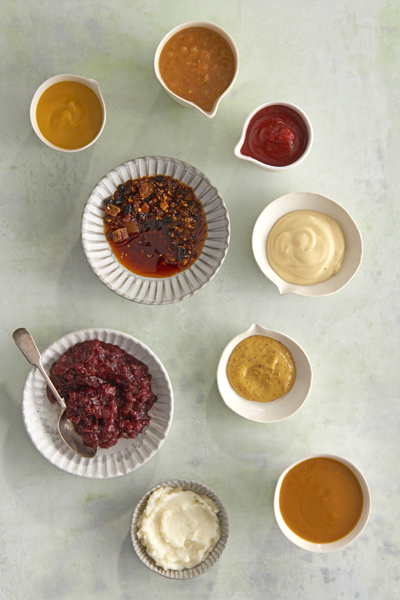The necessity of at-home cooking over the past year reinvigorated center store grocery, and shelf-stable condiments, dressings, and marinades benefitted as tools for livening up daily meals.
Breakfast, lunch, dinner, and snacks prepared largely at home over the past 13 months have had consumers reaching for products to help change up recipes and avoid boredom. “We’ve seen a reinvigoration of the pantry for people who didn’t see it as a life saver before,” says Kara Nielsen, director of food & drink at WGSN, a global trend forecasting firm.
Like many pantry items, shelf-stable condiments, dressings, and marinades have been go-tos during COVID-related sheltering at home, boosting sales in the mature category. But global flavors and healthful attributes are as important to consumers as convenience.
Sales Stats and Outlook
Sales of specialty shelf-stable condiments, dressings, and marinades hit $2.2 billion in 2019, a 9.6 percent increase over 2017, making it one of only 12 categories with sales in excess of $2 billion, according to the Specialty Food Association’s State of the Specialty Food Industry research, 2020-2021 edition. Specialty sales comprise a quarter of sales in the total condiments, dressings, and marinades category.

Terrapin Ridge Farms Raspberry Wasabi Mustard
Along with other center store grocery categories, shelf-stable condiments, dressings, and marinades got an above-average sales lift during spring 2020’s first COVID-19 surge, growing 34 percent in March-April 2020 alone. Overall, from January-April 2020 the category grew 19.9 percent versus a year prior, about the same rate as all shelf-stable condiments, dressings, and marinades.
Market researcher Mintel, which partnered with SFA on the 2020-2021 State of the Industry research, expects growth to continue. Mintel forecasts category sales to hit $2.9 billion by 2024, 5.7 percent growth from 2020, versus 3.9 percent growth in the previous five years (2015-2019).
Category Drivers
While at-home cooking is the overarching trend driving the category, several specific subtrends position condiments, dressings, and marinades as favorite cooking aides. The SFA’s Trendspotter Panel, a group of retailers, chefs, foodservice professionals, market researchers, journalists, food educators, and other industry professionals, identified many of these related trends in its 2021 predictions, and also noticed them going strong at the Association’s Specialty Food LIVE! virtual marketplace event held in January. These subtrends include:
Restaurant-Level Ingredients and Products. Since the pandemic, many people are trying to recreate dining-out experiences while staying at home with the help of products like condiments, marinades, cooking sauces, and dressings, that offer culinary exploration as well as convenience.
“Restaurant brands and chefs also are bringing their talents to CPG,” says Trendspotter Jonathan Deutsch, a professor of Culinary Arts and Science in the Department of Food and Hospitality Management at Drexel University in Philadelphia and founder/director of the Drexel Food Core Lab. He cites examples like Philadelphia’s Poi Dog sauces now available through retailers like Gotham Grove in Brooklyn, and bottled hot sauces from Cochon Cajun Southern Cooking, a New Orleans restaurant. “We’re also seeing some fine-quality vinaigrettes that go far beyond the gloppy bottled salad dressings we grew up with,” he adds.

Kurtz Orchards Peach Garlic Dressing
Deutsch says we will see more chefs and restaurants bottling their signature flavors with a sauce, dressing, condiment, or marinade, “especially as the hospitality industry remains a challenging sector for chefs to achieve success, as the pandemic has pointed out.”
Global Flavors at Home. Similar to restaurant-level dining at home, consumers are transferring experiences they may have had traveling to their at-home recipes. Some condiments and cooking sauces are keeping home cooking exciting with less-familiar flavor profiles from around the world. “I continue to see authentic and bold flavors that help to capture culture on a plate,” says Trendspotter V. Sheree Williams, publisher of Cuisine Noir magazine, which connects the African diaspora through food, drink, and travel, and owner of boutique consulting firm V. Sheree Creative Enterprises. “Looking at trends over the last 11 years that I have been writing about food, producers are now comfortable with truly representing who they are and the ingredients they grew up with without the worry of whether it’s familiar to the masses or not. They know there is an audience of consumers who want something that is new and different for them to try.”
“Particularly in the marinade space, we are seeing flavors that we are used to seeing in restaurants and at travel destinations coming into our home kitchens in easy-to-use formats,” says Deustch. Examples include Island Bwoy jerk sauces, and Ghanaian shito from Hutwise, a retailer of African and Caribbean foods. “Strong flavors like fish sauce or sauces that used to be ‘exotic,’ for many consumers, have become accessible, flavor-rich allies for home cooking.”

Clark + Hopkins Quintana Roo Pepper Sauce
Global chili-based condiments are gaining fans in the mainstream, according to the “Key Trend 2021: Global Chili Condiments” report from WGSN. Among those WGSN identifies for consumers looking to customize dishes with a cuisine-specific flavor and heat kick are Japanese yuzu kosho, originated in Japan’s southernmost region and made with green togarashi chili pepper, and Hong Kong XO sauce. Named after the Cognac XO Hennessy to convey premium, it often includes dried shrimp and scallops as a base, which are blended with garlic, chilies, brown sugar, and soy sauce and can be used to infuse marinades. Indonesian sambal, a staple southeast Asia condiment, contains red Lombok bird’s eye and katokkon chili varieties and can be used as a side sauce. Chinese chili crisp is a garnish or dipping sauce oil-based condiment made with fried chili peppers. Yemeni zhoug is a blend of green chilies, coriander, parsley, cumin, and garlic. It can be used in dressings and marinades on barbecued meats. Trader Joe’s, Central Market, and Waitrose in the U.K., are among retailers who brought in zhoug in their condiment mix, says WGSN.
“Chili peppers emphasize bold flavor but beyond extreme heat,” says Nielsen. “They bring different flavor profiles and different textures as in the case of chili crisp, that deliver a multi-sensory experience.”
Challenges and Differentiators
One of the category’s biggest challenges is that it is mature and, especially in the condiments segment, contains several well-funded CPG global brands, making it difficult for new brands to compete and garner attention on the retail shelf.
Clean, quality ingredients are increasingly points of differentiation. “Catering to consumers who look for products that complement their healthy lifestyle is a continuing trend,” says Williams, “so we will see more focused on no- to low-salt, gluten-free, low sugar and, of course, one of the fastest-growing trends, vegan.”

Circle B Ranch Marina's Cranberry Chutney
Clean, simple ingredients are reinventing the salad dressing category in particular. In its “Key Trend 2021: Salad Dressing” report, WGSN notes that consumer desire to add flavor to their meals is extending beyond condiments to salad dressings. But shoppers are seeking pourable health and added nutrition in addition to flavor.
Up to now, some retailers have seen a drop off in traditional salad dressings because of artificial ingredients. “Olive oils and balsamic vinegar are better sellers for us than salad dressings,” says E. Sue Bicksler-Taub, owner of Holbrook Cottage, a specialty retailer and gift store, in Briarcliff Manor, New York.
At Liberty Heights Fresh, proprietor Steven Rosenberg opts to make dressings from standalone extra virgin or nut oils, balsamic vinegars, freshly pressed citrus juice, and herbs and spices. “Far too often the oils contained in a shelf-stable dressing or marinade has been sourced for low cost rather than high integrity and we have been underwhelmed,” he notes.

Mrs Bridges Traditional English Mustard
Increasingly, the health profile in dressings is under improvement. Nuts, including cashews and pili nuts from the Philippines, are being added for protein, healthy fat, and fiber, and seeds like pumpkin, sunflower, and sesame, are added to the dressings rather than used as an optional topping, says the WGSN report. Additionally, classic dressings are being updated with plant-based ingredients like aquafaba and nut-based dairy to appeal to vegan diets. Lesser-known vinegars and oils from around the world are also being integrated into dressings for taste and healthfulness. “It’s still a little early, but better oils like olive and nut oils are showing a real sophistication on the rise,” says Nielsen.
Dressings, condiments, and marinades are a source of hidden sugars, though they are eaten in small amounts, points out Deutsch. Low-no sugar, keto-friendly is a growing area, with some products turning date or maple syrup as sweeteners.
“Low sugar is a popular request,” says Bicksler-Taub, who adds that marinades and grill sauces are a number-one category for the store from May through August and tapenades have increased in the past year.
Condiment Classics
The rise of plant-based options in traditional condiments is a trend that can’t be denied, says Nielsen. She points to more vegan mayonnaise, made from chickenless eggs, aquafaba, or mung beans as an egg substitute, as an area where consumers can expect to see more in both retail and foodservice.
“A plant-based wave is coming where we could see restaurants or families defaulting to the vegan option for condiments like mayo and some dressings too,” she says. “And it won’t be compromised tastewise.”
Flavor fusions, too, have been happening for a while in traditional condiment categories like catsup, mustard, and mayonnaise, with mixes like aioli and catsup/mayo blends. But Nielsen says there is still a place for the classics.

Rinci Sea Fennel Mayonnaise
“The fusions will keep branching out,” she says, “but from eating at home, whether trying to moisten or tie together a sandwich or a veggie burger, there’s a new resonance for the classic condiments.”
Editor’s note. Given the breadth of the condiments, marinades, dressings, and cooking sauces category, it is difficult to cover everything in one article. This feature focuses on shelf-stable versus fresh condiments. Barbecue sauces and a deeper look at hot sauces will be covered separately.
4 Trends to Watch for in Condiments, Dressings, and Marinades
We asked SFA Trendspotters and market researchers what trends they are seeing or expect to emerge in the category.
1. Fermented condiments and sauces. Products that contain probiotics or are naturally fermented, will grow in popularity. WGSN sees fermented chilies in hot sauces as a rising trend as appreciation of sour, tangy flavor grows. Kimchi and miso are also ingredients showing up increasingly in dressings.
2. Functional attributes. Functional ingredients and their associated benefits that have become common in categories like tea, chocolate, snacks, and RTD beverages will seep into this category. “I see the fusion of ingredients that consumers may not be looking for or expect such as more CBD and cannabis. I haven’t personally seen them in these products, but I am sure they are coming,” says V. Sheree Williams, publisher of Cuisine Noir magazine.
3. Versatile, all-in-one products. “Many consumers are looking for products with multiple purposes so if they can have one product that fits their marinade, sauce, and condiment needs, they are sold,” says Williams.
4. Values-based shopping. With much of the social action that has been occurring in the past year, people are voting with their dollars, whether it’s supporting Black-owned or POC-owned businesses or companies with ethical or sustainable business practices. “In this crowded space, a good brand will tell a good story,” says Jonathan Deutsch, professor of Culinary Arts and Science in the Department of Food and Hospitality Management at Drexel University. “BIPOC-, veteran-, woman-owned, B-corp, upcycled, employing people of diverse abilities, charitable, and more are not just the story of the business but the story of the brand and why it should be on your table.”
Products Recently Introduced to Market
Anne’s Toum Lebanese Garlic Sauce. Traditional Lebanese garlic sauce from a family recipe that can be used as an all-purpose condiment. Organic, vegan, gluten-free, and non-GMO. Available in Original Toum, Za’atar Toum, and Lemon Sumac Toum. annestoum.com
Circle B Ranch Marina’s Cranberry Chutney. This fresh, sweet chutney is made from whole cranberries and oranges and a touch of spice. Serve on pork, chicken, or turkey or with goat cheese or baked brie. circlebranchpork.com
Clark + Hopkins Quintana Roo Pepper Sauce. Quintana Roo is a Mexican state on the Yucatan peninsula and is home to the rich Mayan culture and spicy cuisine with habaneros and citrus fruits. This spicy pepper sauce goes with fish tacos, carnitas, egg dishes, seafood, vegetables, and chicken. clarkandhopkins.com
Hlthpunk Bionnaise Organic Vegan Mayo. Plant-based oat mayonnaise made from organic ingredients: sunflower oil, oat milk (water, oats), vinegar, pea protein, sea salt, black salt, ashwagandha, acerola, asafoetida, lemon juice concentrate, carrot juice concentrate, white pepper, turmeric. hlthpunk.com
Kurtz Orchards Peach Garlic Dressing. Niagara peaches and lots of garlic have been combined in this dressing. Versatile and can be tossed on oven baked baby potatoes, or on grilled chicken, pork, or fish. kurtzorchards.com
Mrs Bridges Traditional English Mustard. A British classic to serve with ham to liven up a sandwich, or as part of a condiment selection at the dinner table. mrsbridges.co.uk
oo’mämē Moroccan Chile Crisp. Celebrating the history of ancient markets. Traditionally, 27 spices make up this blend. Every store and every family have their own recipe. This Arabic name, meaning “head of the shop,” promotes the proprietary blend of the best possible spices that the seller currently has on hand. This unique blend, like Ras el Hanout, relies on peppercorns, red chilies, nutmeg, cinnamon, clove, ginger, anise, coriander and more, but are left whole rather than using ground spices. oomame.net
Rinci Sea Fennel Mayonnaise. Sea fennel, known as “paccasassi” in the local dialect, is an aromatic succulent plant traditionally eaten in the Marche region of Italy. The founders of Rinci reinterpreted this regional delicacy in a line of preserves and sauces. Their artisanal mayonnaise is vegan and is delicately flavored with puréed sea fennel. It is creamy, yet light, sweet and tangy and complements seafood as a garnish or as a dipping sauce. manicaretti.com
Spirit & Co. Vodka & Italian Tomato Ketchup. This distinctive Vodka & Italian Tomato Ketchup is hand-crafted in small batches with premium American vodka from select grain, distilled four times, and bottled in Kentucky. spiritsauces.com
Terrapin Ridge Farms Raspberry Wasabi Mustard. A mild wasabi kick and sweet raspberry puree are blended with creamy mustard to create a velvety condiment for dipping finger foods or topping sandwiches. Ideal accompaniment for cheese and charcuterie boards as well as to top deviled eggs or glaze a ham or pork loin. terrapinridge.com
Denise Purcell is vice president of content and education for the Specialty Food Association.
Photos: Mark Ferri; Props Styling: Francine Matalon-Degni; Food Styling: Leslie Orlandini

